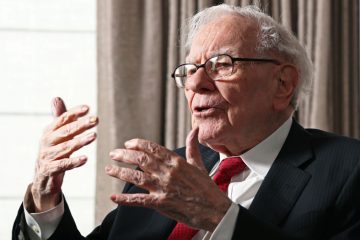Warren Buffett (Trades, Portfolio) has famously said the following statement:
“If I was running $ 1 million today, or $ 10 million for that matter, I’d be fully invested. Anyone who says that size does not hurt investment performance is selling. The highest rates of return I’ve ever achieved were in the 1950s. I killed the Dow. You ought to see the numbers. But I was investing peanuts then. It’s a huge structural advantage not to have a lot of money. I think I could make you 50% a year on $ 1 million. No, I know I could. I guarantee that.”
I am sure every investor wants to find out how would he make 50% a year guaranteed. A logical starting point is his rates of return as well as portfolio details in the 1950s. Unfortunately there is extremely limited information out there with regards to his return and portfolio composition. Therefore, I was delighted to find the following information from Andrew Kilpatrick’s book “Of Permanent Value.” The following information was contained in a letter Warrren Buffett wrote to Andrew Kilpatrick in 2001. This table shows the details of his investment from 12/31/1950 to 12/31/1951. Let’s take a look:
12/31/50
Buffett & Co. $ 591.20
Selected Industries (1200@3 1/8) 3,750.00
U.S & International Securities (700 @ 4 1/8) 2,887.50
Parkersburg Rig & Reel ( 200 @13) 2,600.00
Total $ 9,828.70
Less Loss on Interest in Marshall Wells (12 ½ @198) 25.00
Net Assets $ 9,803.70
12/31/51
Buffett-Falk & Co. $ 292.63
Dividends receivable 140.00
Government Employees Insurance (350 @ 37 ½) 13,125.00
Timely Clothes (200@13) 2,600
Baldwin Co. (100@22) 2,200.00
Greif Brothers Cooperage “A” (200@18 ¼) 3,650.00
Des Moines Railway 5’s -1955 (2000@33) 330.00
Thor Corp. (200 @12 ¾) 2,550.00
Total: $ 24,876.63
Less Bank Loans : $ 5,000.00
Loss on interest in Cleveland Worsted Mills (25@95) 150.00
Total Deductions : $ 5,150.00
Net Assets: 19,737.63
Net Increase in Investment Account $ 9,933.93
Less: Capital Additions 2,500.00
Net Gain from Investments: 7,433.93
Percentage Gain on 12/31/50 Net Assets : 75.8%
Dow-Jones Industrials 12/31/51: 269.23
Dow-Jones Dividends – 1951: 16.34
Total:285.57
Less: Dow-Jones Industrials 12/31/50: 235.41
Gain in Dow-Jones Industrials:50.16
Percentage Gain on 12/31/50 Dow-Jones Industrials 21.3%
Wow! Buffett did kill the Dow in 1951 with a return of a mind-blowing 75.8% versus the Dow’s 21.3%.
Here are a few observations:
- Buffett put more than half of his net assets in GEICO after he found out that Ben Graham was heavily invested in it and after he spent a few hours with Lorimer Davidson.
- His next four largest positions such as Thor Corp and Timely Clothes made up 9% to 15% of his portfolio.
- Together, his five largest holdings accounted for a whopping 97% of his portoflio.
- Buffett’s 75.8% return is leveraged as he borrowed $ 5,000 in 1951, probably to finance the Geico purchase.
- None of the year-end 1950 holdings were included in the year-end 1951 holdings, implying that Buffett flipped them within a year.
- This doesn’t include his short position in Kaiser-Frazer, which you can find more detailes in Alice Shroeder’s “Snowball.”
I think the following lessons offer some foods for thought:
- Bet big when the odds are extremely in your favor, such as Buffett’s investment in GEICO. But only if you have done enough scuttlebutt work on your own and the investment is within your circle of competence. A related topic, which will require another full article, is the concept of expected return.
- This may sound controversial, but It is okay to use some leverage when the odds are good. Both Buffett and Munger used leverage in their early investment life. Especially when you are still young and have nothing to lose. But his lesson only applies to intelligent investing, not to speculation and gambling alike.
- You don’t have to hold a stock for five to 10 years just to prove you are long-term oriented. Mohnish Pabrai (Trades, Portfolio) once said something like for most of us, the stocks that can make us 50% a year will likely not take that long to get us the results. Of course if you prefer quality and are satisfied with a 10% to 15% annual compounded return, a longer time horizon may work better.








